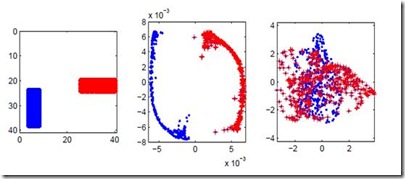In this paper, we explore how to use topological tools to compare dimension reduction methods. We first make a brief overview of some of the methods often used dimension reduction such as Isometric Feature Mapping, Laplacian Eigenmaps, Fast Independent Component Analysis, Kernel Ridge Regression, t-distributed Stochastic Neighbor Embedding. We then give a brief overview of some topological notions used in topological data analysis, such as, barcodes, persistent homology, and Wasserstein distance. Theoretically, these methods applied on a data set can be interpreted differently. From EEG data embedded into a manifold of high dimension, we apply these methods and we compare them across persistent homologies of dimension 0, 1, and 2, that is, across connected components, tunnels and holes, shells around voids or cavities. We find that from three dimension clouds of points, it is not clear how distinct from each other the methods are, but Wasserstein and Bottleneck distances, topological tests of hypothesis, and various methods show that the methods qualitatively and significantly differ across homologies.
翻译:暂无翻译



